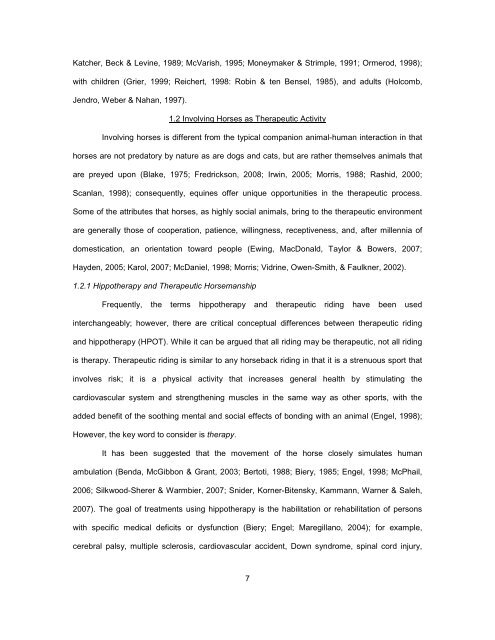A SYSTEMATIC REVIEW OF THE EFFECTS OF PSYCHOTHERAPY ...
A SYSTEMATIC REVIEW OF THE EFFECTS OF PSYCHOTHERAPY ...
A SYSTEMATIC REVIEW OF THE EFFECTS OF PSYCHOTHERAPY ...
Create successful ePaper yourself
Turn your PDF publications into a flip-book with our unique Google optimized e-Paper software.
Katcher, Beck & Levine, 1989; McVarish, 1995; Moneymaker & Strimple, 1991; Ormerod, 1998);<br />
with children (Grier, 1999; Reichert, 1998: Robin & ten Bensel, 1985), and adults (Holcomb,<br />
Jendro, Weber & Nahan, 1997).<br />
1.2 Involving Horses as Therapeutic Activity<br />
Involving horses is different from the typical companion animal-human interaction in that<br />
horses are not predatory by nature as are dogs and cats, but are rather themselves animals that<br />
are preyed upon (Blake, 1975; Fredrickson, 2008; Irwin, 2005; Morris, 1988; Rashid, 2000;<br />
Scanlan, 1998); consequently, equines offer unique opportunities in the therapeutic process.<br />
Some of the attributes that horses, as highly social animals, bring to the therapeutic environment<br />
are generally those of cooperation, patience, willingness, receptiveness, and, after millennia of<br />
domestication, an orientation toward people (Ewing, MacDonald, Taylor & Bowers, 2007;<br />
Hayden, 2005; Karol, 2007; McDaniel, 1998; Morris; Vidrine, Owen-Smith, & Faulkner, 2002).<br />
1.2.1 Hippotherapy and Therapeutic Horsemanship<br />
Frequently, the terms hippotherapy and therapeutic riding have been used<br />
interchangeably; however, there are critical conceptual differences between therapeutic riding<br />
and hippotherapy (HPOT). While it can be argued that all riding may be therapeutic, not all riding<br />
is therapy. Therapeutic riding is similar to any horseback riding in that it is a strenuous sport that<br />
involves risk; it is a physical activity that increases general health by stimulating the<br />
cardiovascular system and strengthening muscles in the same way as other sports, with the<br />
added benefit of the soothing mental and social effects of bonding with an animal (Engel, 1998);<br />
However, the key word to consider is therapy.<br />
It has been suggested that the movement of the horse closely simulates human<br />
ambulation (Benda, McGibbon & Grant, 2003; Bertoti, 1988; Biery, 1985; Engel, 1998; McPhail,<br />
2006; Silkwood-Sherer & Warmbier, 2007; Snider, Korner-Bitensky, Kammann, Warner & Saleh,<br />
2007). The goal of treatments using hippotherapy is the habilitation or rehabilitation of persons<br />
with specific medical deficits or dysfunction (Biery; Engel; Maregillano, 2004); for example,<br />
cerebral palsy, multiple sclerosis, cardiovascular accident, Down syndrome, spinal cord injury,<br />
7
















